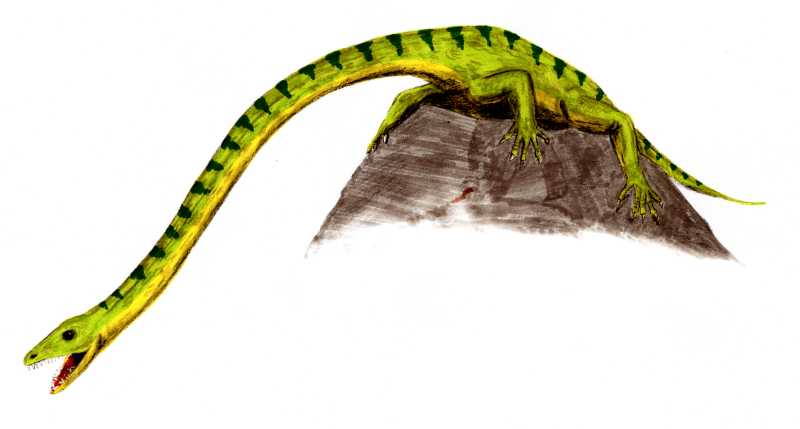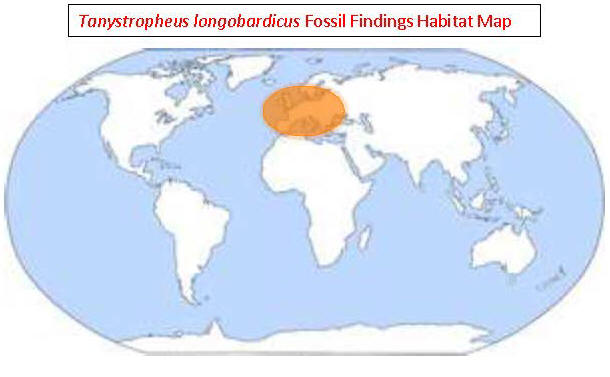Habitat
Tanystropheus longobardicus’ habitat is still debated by scientists today. Many scientist believe that this strange creature lived on the land preying on fish. Silvio Renesto writes about this, stating that the structure of the tail and limbs are consistent with a shoreline habitat rather than a fully aquatic lifestyle (Renesto, 2005). To explore more about life on land and the adaptations of a terrestrial lifestyle in the T. longobardicus check out our adaptations page.
Tanystropheus longobardicus lived around 215 million years ago (Richardson, 2003), during the early late Triassic period (Fraser, 2003) or also known as the Ladinian stage (Dal Sasso and Brillante, 2004). Fossils of such time period have been found in an area referred to as Grenzbitumenzone, a middle Triassic formation that is a 16 meter thick sequence of finely stratified, organic-rich dolomites and black shales (Bernasconi and Riva, 1993).
Tanystropheus longobardicus was first discovered in Germany in the 1830s (Haines and Chambers, 2006). However, T. longobardicus fossils have been found mainly in semiaquatic sites, primarily in central parts of Europe (Fraser, 2006), but also found outside of Italy, the Middle East and China (Renesto, 2005). There are a couple of features of T. longobardicus that cause scientists to believe that they lived in water. One of these features is its long neck, making it difficult to maintain posture on land, where as water offered more support (Fraser, 2006). But on the other hand, the teeth of the juvenile T. longobardicus have strongly mixed tooth types, with multicuspid cheek teeth in the posterior jaw (Fraser, 2006). These teeth would suggest a insectivorous diet, however other scientist believe that these types of teeth suggest a vegetative diet on algae (Dal Sasso and Brillante, 2004). Even the smallest T. longobardicus have extraordinarily long necks, making life on land difficult. Another reason why the movement of the neck is limited is due to the direction of the ribs. The ribs on the T. longobardicus are slender and extend posteriorly well past the subsequent vertebrae. Thus resulting in a bundle of overlapping ribs, severely restricting the movement of the neck (Fraser, 2006).
The marine component of the Grenzbitumenzone and the abundance of the Tanystropheus specimens convincingly argues for the aquatic lifestyle (Fraser, 2006). It is hypothesized that Tanystropheus longobardicus lived in the water for the most part due to the gravitational strain of their neck length. However, they were not good swimmers. By swishing their tails from side to side they would have swum through the waters at quite a low speed (Haines and Chambers, 2006). A study done by Stefania Nosotti in 2007 that reaffirmed the hypotheses of the aquatic lifestyle among T. longobardicus living in water by undulations (wave like bends) of the neck and back (Nosotti, 2007).
